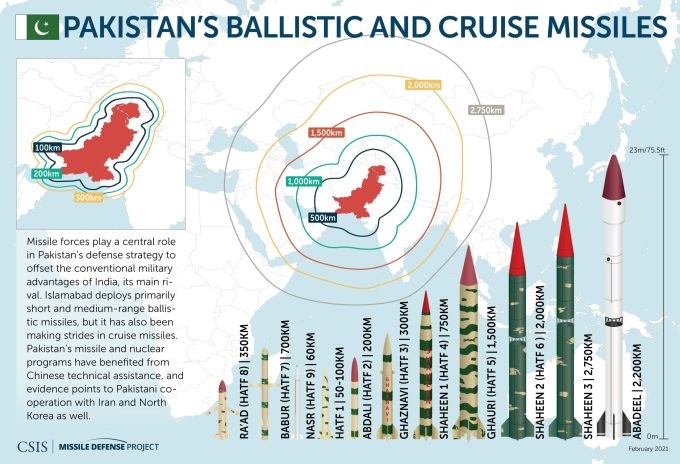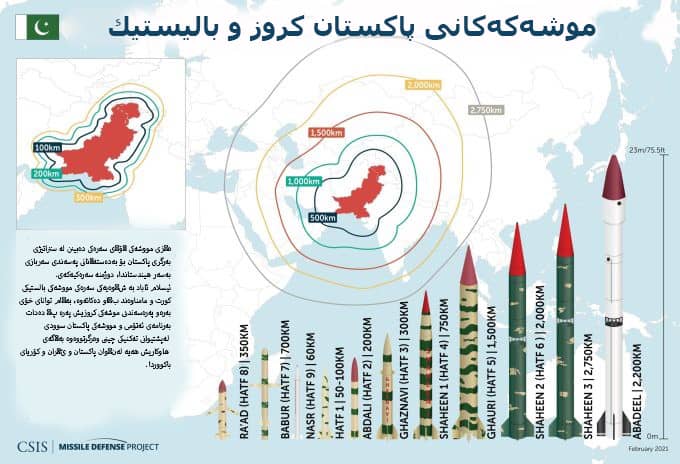 Pakistan’s nuclear weapons program was established in 1972 by Zulfiqar Ali Bhutto, then the President of Pakistan. India’s 1974 testing of a nuclear “device” and hostile statements by the Indian leadership, gave Pakistan’s nuclear program a new momentum. Through the late 1970s, Pakistan’s program acquired sensitive uranium enrichment technology and expertise. The 1975 arrival of Dr. Abdul Qadeer Khan considerably advanced these efforts. Dr. Khan was a German-trained metallurgist who brought with him knowledge of gas centrifuge technologies that he had acquired through his position at the classified URENCO uranium enrichment plant in the Netherlands. He was put in charge of building, equipping and operating Pakistan’s Kahuta facility, which was established in 1976. Under Khan’s direction, Pakistan employed an extensive clandestine network in order to obtain the necessary materials and technology for its developing uranium enrichment capabilities.
Pakistan’s nuclear weapons program was established in 1972 by Zulfiqar Ali Bhutto, then the President of Pakistan. India’s 1974 testing of a nuclear “device” and hostile statements by the Indian leadership, gave Pakistan’s nuclear program a new momentum. Through the late 1970s, Pakistan’s program acquired sensitive uranium enrichment technology and expertise. The 1975 arrival of Dr. Abdul Qadeer Khan considerably advanced these efforts. Dr. Khan was a German-trained metallurgist who brought with him knowledge of gas centrifuge technologies that he had acquired through his position at the classified URENCO uranium enrichment plant in the Netherlands. He was put in charge of building, equipping and operating Pakistan’s Kahuta facility, which was established in 1976. Under Khan’s direction, Pakistan employed an extensive clandestine network in order to obtain the necessary materials and technology for its developing uranium enrichment capabilities.
In 1985, Pakistan crossed the threshold of weapons-grade uranium production, and by 1986 it is thought to have produced enough fissile material for a nuclear weapon. Pakistan continued advancing its uranium enrichment program, and according to Pakistani sources, the nation acquired the ability to carry out a nuclear explosion in 1987.As a response to India conducting five nuclear tests on 11 and 13 May,1998 Pakistan tested its nuclear devices on 28 May. The Pakistani Atomic Energy Commission reported that the five nuclear tests conducted on May 28 generated a seismic signal of 5.0 on the Richter scale, with a total yield of up to 40 KT (equivalent TNT). Dr. A.Q. Khan claimed that one device was a boosted fission device and that the other four were sub-kiloton nuclear devices. Details are reflected as follows:
| DEVICE | DATE | YIELD [announced] |
YIELD [estimated] |
| [boosted device?] | 28 May 1998 | 25-36 kiloton | total 9-12 kiloton |
| Fission device | 28 May 1998 | 12 kilotons | |
| Low-yield device | 28 May 1998 | sub-kiloton | — |
| Low-yield device | 28 May 1998 | sub-kiloton | — |
| Low-yield device | 28 May 1998 | sub-kiloton | — |
| Fission device | 30 May 1998 | 12 kilotons | 4-6 kiloton |
| Fission device | not detonated | 12 kilotons | — |
Pakistan’s nuclear tests were followed by the February 1999 Lahore Agreements between Prime Ministers Vajpayee and Sharif. The agreements included confidence building measures such as advance notice of ballistic missile testing and a continuation of their unilateral moratoria on nuclear testing.
Pakistan’s nuclear program is based primarily on highly enriched uranium (HEU), which is produced at the A. Q. Khan research laboratory at Kahuta, a gas centrifuge uranium enrichment facility. The Kahuta facility has been in operation since the early 1980s. By the early 1990s, Kahuta had an estimated 3,000 centrifuges in operation, and Pakistan continued its pursuit of expanded uranium enrichment capabilities.
In the 1990s Pakistan began to pursue plutonium production capabilities. With Chinese assistance, Pakistan built the 40 MWt (megawatt thermal) Khusab research reactor at Joharabad, and in April 1998, Pakistan announced that the reactor was operational. According to public statements made by US officials, this heavy water reactor generates an estimated 8-10 kilotons of weapons grade plutonium per year, which is enough for one to two nuclear weapons. The reactor could also produce tritium if it were loaded with lithium-6. Khusab’s plutonium production capacity could allow Pakistan to develop lighter nuclear warheads that would be easier to deliver with a ballistic missile.
According to The Nuclear Notebook of the Federation of American Scientists, by 2021 Pakistan has 165 HEU-based nuclear warheads. This puts Pakistan ahead of Indian stockpiles of nuclear warheads. Pakistan like its arch rival India, also has a sea based second strike capability. Pakistan’s nuclear warheads are based on an implosion design that uses a solid core of highly enriched uranium and requires an estimated 15-20 kg of material per warhead. According to Carnegie, Pakistan has also produced a small but unknown quantity of weapons grade plutonium, which is sufficient for an estimated 5-10 nuclear weapons.
Pakistan is pursuing a “full spectrum deterrence posture” which includes long range missiles and aircrafts for strategic missions as well as several short-range lower yield nuclear capable weapon systems in order to counter military threats below strategic level. The Nuclear and Missiles programs and its employment are handled by Strategic Planning Division (SPD), which is headed by a three-star general and works under the Chairman Joint Chiefs of Staff. The SPD is headed by the Prime Minister of Pakistan and its important meetings, depending on the environments are attended by relevant federal ministers, besides all the services chiefs.
Pakistan’s rapidly evolving missile arsenal forms an important part of its defense strategy for offsetting the significant conventional military advantages of its main rival, India. Pakistan’s arsenal consists primarily of mobile short and medium-range ballistic missiles, but it is also making significant strides in its cruise missile capability. Pakistan’s combined strategic forces allows it to target almost any point in India, and is now working more advanced technology such as multiple independent reentry vehicles (MIRV) to complicate developing Indian missile defense efforts. Pakistan has received significant technical assistance from China on its nuclear and missile programs.
| Missile Name | Class | Range | Status |
| Ababeel | MRBM | 2,200 km | Operational |
| Abdali (Hatf 2) | SRBM | 180 – 200 km | Operational |
| Babur (Hatf 7) | Cruise Missile | 350 – 700 km | Operational |
| Exocet | ASCM | 40 – 180 km | Operational |
| Hatf 5 “Ghauri” | MRBM | 1,250 – 1,500 km | Operational |
| Ghaznavi (Hatf 3) | SRBM | 290 km | Operational |
| Hatf 1 | SRBM | 70 – 100 km | Operational |
| Nasr (Hatf 9) | SRBM | 70 km | In service |
| Ra’ad (Hatf 8) | Cruise Missile | 350 km | Tested in 2007 |
| Shaheen 1 (Hatf 4) | SRBM | 750 – 900 km | Operational |
| Shaheen 2 (Hatf 6) | MRBM | 1,500 – 2,000 km | Operational |
| Shaheen 3 | MRBM | 2,750 km | Operational |
Pakistan is pursuing an Offensive-Defense and its war fighting strategy is based on maintaining both a Conventional and Nuclear deterrence. It has fought three major wars and many skirmishes with India due to the unresolved issue of Jammu and Kashmir, which according to British formula for the division of Indian sub-continent in 1947, should have been part of Pakistan, being a Muslim majority state. The Nuclear program has given Pakistan the longest era of peace since the last war of 1971. Being only Muslim Nuclear-powered state, its program is focus of subversion by many hostile states. The safety standards applied to the nuclear reactors and the war heads have been continuously monitored by International Atomic Energy Commission and other world bodies and have been acclaimed. As a responsible nuclear state, Pakistan remains committed to the observance of highest safety standards and its prime use as a deterrence against any aggression.

